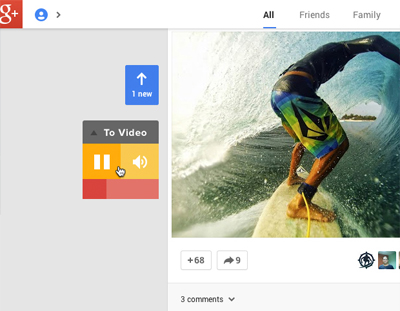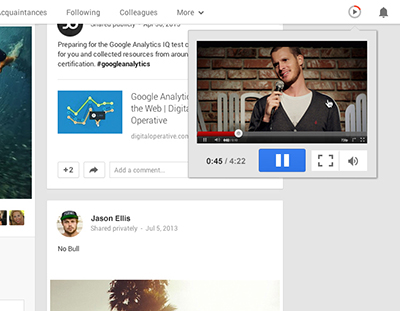September 25, 2013
By BJ Cook,
Hats off to the YouTube team. They get it. They realize that people want to watch and listen to video while seeking the next piece of content they'd like to consume. It makes sense… Afterall, you could be listening to a TED talk and then discover a short Instagram clip you want to watch simultaneously. Or you could be listening to a music video while searching out your next jam to play. Use case after use case, there's reason to allow the user to explore the stream, without stopping the video.
Unfortunately, this U/X revelation hasn't made it over to the Google Plus product team. At least not yet.
You'll notice that consuming video in your stream is a linear and rigid process; one action overrides another. That is, once you start watching a video you can't do anything else without interrupting that experience. And that needs to change.
We love watching video and we love our infinite streams of content. But the two together present some challenges if you ever want to do the internet equivalent of walking and chewing bubble gum.
That's why our team set out to show our readers how we would solve this problem. Our first challenge, how do you get back to a video that's playing in the infinite stream to play, pause, or adjust the volume. In order to solve this issue, we took a page out of the "New Posts" playbook. When you're watching a video and scroll away from it, you'll notice an overlay in the left corner that will easily jump you back to this content. Handy!
What's more, what if you wanted to queue this video to play after the one you're watching… a la iTunes. Well, we've solved for that too. Just add a simple Play Now, Play Next button to the videos and voilà, a better stream experience for movies.
We know Google is probably working on this exact issue as we post this… heck, they've already solved this challenge for YouTube.
We want our readers to know that, like Google, we're thinking about how to solve big user interaction challenges too. Our experts aim to reduce the friction that's inherent to new web experiences. We do this for companies we respect, like Google, and we do it for family of clients month in and month out.
We love what we do here at DO and it's our ambition to make the web an easier place to do the things you love. If you're interested in us solving a web headache your team has been grappling with, please don't be hesitant to reach out to us.






